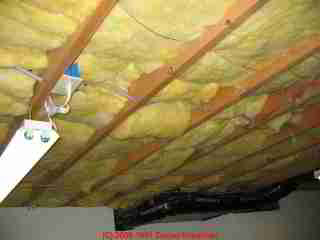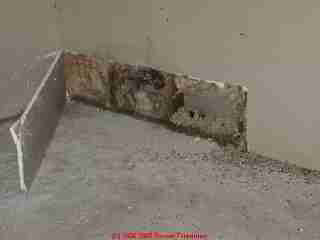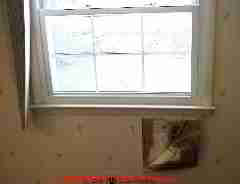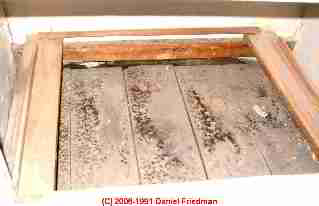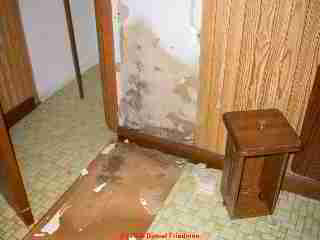 Find Hidden Mold Reservoirs in the Home
Find Hidden Mold Reservoirs in the Home
Guide to detection of hidden building mold
- POST a QUESTION or COMMENT about how to go about finding hidden mold contamination in buildings
How to find hidden mold contamination:
What do we do when we cannot find a mold problem but we think there is problem mold in a building. Suppose an "air test" says there is problem mold indoors but you don't see where the "problem mold" is coming from? Where and How do we look for hidden mold?
InspectAPedia tolerates no conflicts of interest. We have no relationship with advertisers, products, or services discussed at this website.
- Daniel Friedman, Publisher/Editor/Author - See WHO ARE WE?
Where to Look When You Cannot Find the Mold Problem in a Building
Where to look for "Invisible Mold" in buildings - important mold reservoirs that cannot be detected by visual inspection
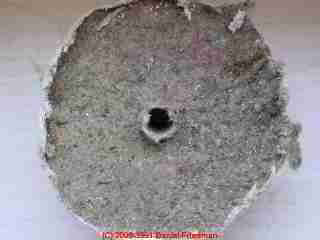 Results of a small test cut to check for hidden mold
Results of a small test cut to check for hidden mold
Of course some important problematic mold reservoirs may be hidden inside building cavities where you won't see them without making a test cut in just the right place.
We find these problems by inspecting "by context", that is, we decide where to make an invasive test cut by studying where leak or moisture problems have been or are likely to have been on a building.
This photo shows the hidden interior side of drywall on the test cut we made using the hole saw shown at the top of this page. The red material was a yeast which accompanied toxic mold which we confirmed was present in this wall cavity.
What's important is the development of a strategy for just where to make such test cuts to look for hidden mold. Random test cuts to screen a building for mold are unreliable.
Some other critical indoor mold problems may be on an exposed building surface or material, but the mold may be totally invisible to the naked eye.
Such "hidden in plain sight mold" can be detected by a combination of common sense in recognizing mold-friendly materials and mold-producing conditions.
Exposed insulation may be mold contaminated
For example, fiberglass insulation in the ceiling over a flooded basement or crawl space is highly suspect. In some cases it's more economical and sensible to simply replace suspect material than to spend on testing it for mold contamination.
But where large areas or large expense would be involved, special testing methods can determine whether insulation or other mold reservoir materials are indeed mold-contaminated. We use a combination of vacuum pump and sampling cassettes to examine suspect building insulation.
See Mold in Fiberglass Insulation for details of the occurrence of mold contamination in building insulation.
See Vacuuming building cavitiesas a screen for building mold as well as VACUUM TEST INSULATION CONTAMINANTS for finding mold-contaminated fiberglass.
Below is a photo taken in our laboratory when we examined our sample of insulation which we suspected would be mold-contaminated.
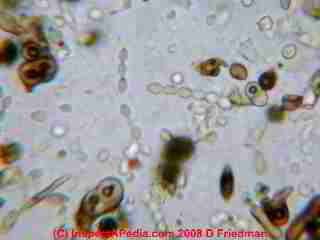 You can see extensive mold contamination of at least two types, Penicillium/Aspergillus spores and spore chains and darker fungal spores which are probably a species of Cladosporium sp. This insulation looked "clean" to the naked eye, but by context we suspected it would be a problem reservoir of mold.
You can see extensive mold contamination of at least two types, Penicillium/Aspergillus spores and spore chains and darker fungal spores which are probably a species of Cladosporium sp. This insulation looked "clean" to the naked eye, but by context we suspected it would be a problem reservoir of mold.
Moldy fiberglass insulation is often missed by casual or inexperienced mold inspectors. The presence of spore chains confirms that we had active mold growth nearby if not in the insulation itself.
Making a larger wall test cut to check for hidden mold
Here we made a larger test cut in mold-suspect drywall because we saw a leak stain on the exposed surface.
Even though there was no mold on the exposed side of this wall, the water stain led us via this test cut to discover a leaky drain pipe that was previously unknown.
We would not make a cut like this unless there was external evidence of probable leakage into this cavity; a borescope might have found this problem too, though views through such instruments are quite limited and do not permit full examination of all materials and surfaces. Notice the evidence of mouse activity at the right end of this test cut?
Removing Wallpaper to Check for Hidden Mold
In our daughter's condominium we peeled down clean-looking wallpaper because we saw evidence of a history of leaks into the wall cavity at the window sill. Even though there was no mold on the exposed side of this wallpaper, the water stains led us via this test to discover an area of Stachybotrys chartarum that was worth removing.
We often find mold growth behind wallpaper where there has been leakage or high moisture, including wallpapers used in bathrooms.
Watch out: some antique wallpapers which may be attacked by mold growth can cause the release of poisonous arsenic into the local environment.
See ARSENIC GREEN in WALLPAPER
Hidden Mold Under Furniture Drawers or Built-in Drawers
Simply pulling out a drawer may reveal problem mold growth. In this case we found this by pulling out the bottom draw of a built-in storage chest in a bathroom in an older home. we have also found Aspergillus sp. colonies growing on the un-finished underside of furniture and game tables.
Hidden Mold Behind Wall Paneling
We pulled down this bathroom paneling even though it's exposed side looked very clean, because other clues indicated that there had been a history of floor flooding in this area.
Hidden Black Toxic Mold Behind Drywall
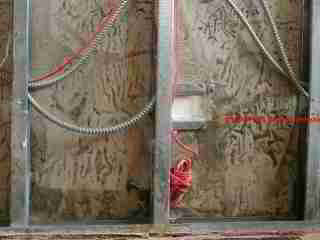
We made the test cut you see in the photo at left above, even though the architect had directed the mold inspection and testing to be performed in a completely different building area.
That's because we saw water-damaged flooring and because occupants of this area were complaining of severe respiratory and eye irritation. We had to push insulation aside to show the black mold just visible in this photo on the cavity side of the opposing drywall.
Our lab test indicated that we'd found Memnoniella echinata (a very close relative of Stachybotrys chartarum) which we find quite irritating.
The second photograph above shows how extensive the mold growth was when the lower wall cavity was cut away.
This mold contamination had spread on 100 linear feet of wall in this area due to an air conditioning leak which drained into the channel formed by the steel u-channel used as a sill plate for this steel-stud wall.
...
Continue reading at HIDDEN MOLD, HOW TO FIND or select a topic from the closely-related articles below, or see the complete ARTICLE INDEX.
Or see these
Recommended Articles
- MOLD ACTION GUIDE - WHAT TO DO ABOUT MOLD
- MOLD APPEARANCE - WHAT MOLD LOOKS LIKE
- MOLD APPEARANCE - STUFF THAT IS NOT MOLD
Suggested citation for this web page
INVISIBLE MOLD at InspectApedia.com - online encyclopedia of building & environmental inspection, testing, diagnosis, repair, & problem prevention advice.
Or see this
INDEX to RELATED ARTICLES: ARTICLE INDEX to MOLD CONTAMINATION & REMEDIATION
Or use the SEARCH BOX found below to Ask a Question or Search InspectApedia
Ask a Question or Search InspectApedia
Try the search box just below, or if you prefer, post a question or comment in the Comments box below and we will respond promptly.
Search the InspectApedia website
Note: appearance of your Comment below may be delayed: if your comment contains an image, photograph, web link, or text that looks to the software as if it might be a web link, your posting will appear after it has been approved by a moderator. Apologies for the delay.
Only one image can be added per comment but you can post as many comments, and therefore images, as you like.
You will not receive a notification when a response to your question has been posted.
Please bookmark this page to make it easy for you to check back for our response.
IF above you see "Comment Form is loading comments..." then COMMENT BOX - countable.ca / bawkbox.com IS NOT WORKING.
In any case you are welcome to send an email directly to us at InspectApedia.com at editor@inspectApedia.com
We'll reply to you directly. Please help us help you by noting, in your email, the URL of the InspectApedia page where you wanted to comment.
Citations & References
In addition to any citations in the article above, a full list is available on request.
- Adkins and Adkins Dictionary of Roman Religion discusses Robigus, the Roman god of crop protection and the legendary progenitor of wheat rust fungus.
- Kansas State University, department of plant pathology, extension plant pathology web page on wheat rust fungus: see http://www.oznet.ksu.edu/path-ext/factSheets/Wheat/Wheat%20Leaf%20Rust.asp
- A BRIEF GUIDE to MOLD, MOISTURE, and YOUR HOME, [PDF] U.S. Environmental Protection Agency US EPA - includes basic advice for building owners, occupants, and mold cleanup operations. See http://www.epa.gov/mold/moldguide.htm
- In addition to citations & references found in this article, see the research citations given at the end of the related articles found at our suggested
CONTINUE READING or RECOMMENDED ARTICLES.
- Carson, Dunlop & Associates Ltd., 120 Carlton Street Suite 407, Toronto ON M5A 4K2. Tel: (416) 964-9415 1-800-268-7070 Email: info@carsondunlop.com. Alan Carson is a past president of ASHI, the American Society of Home Inspectors.
Thanks to Alan Carson and Bob Dunlop, for permission for InspectAPedia to use text excerpts from The HOME REFERENCE BOOK - the Encyclopedia of Homes and to use illustrations from The ILLUSTRATED HOME .
Carson Dunlop Associates provides extensive home inspection education and report writing material. In gratitude we provide links to tsome Carson Dunlop Associates products and services.


